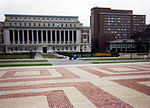Monk's Café

Monk's Café is a fictional coffee shop from the NBC sitcom Seinfeld. The exterior of Tom's Restaurant on the corner of West 112th Street and Broadway, near Columbia University, which first appears in season 1 episode 3, "The Robbery," is often shown on the show as the exterior of Monk's, though the interiors were shot on a sound stage. The restaurant consists of a number of booths, tables, and a counter. Jerry, Elaine, George and Kramer normally sit in the first or second booth from the entrance. The owner of the fictional café is Larry the Cook, played by Lawrence Mandley. He first appears in "The Outing" during season 4. In the season 4 finale, "The Pilot", Elaine is incensed that Monk's "new management" is hiring nothing but big-breasted waitresses. The new owner is identified as Mr. Visaki (played by Al Ruscio) and the well-endowed employees turn out to be his daughters. However, in the season 5 episode, "The Wife", Larry has returned as the owner/manager and appears in that role throughout the remainder of the show's run. Monk's cashier's name is Ruth Cohen, sharing her name with the actress that portrays her. "Ruthie" appears in 101 of the 180 Seinfeld episodes, the most of any character other than the four leads. In most appearances, she appears as a non-speaking background character. Jerry refers to a competing coffee shop, Reggie's, as "the bizarro coffee shop." According to George, it has practically the same menu but is disliked by Jerry and Elaine (in "The Soup") for its failure to serve an "egg white omelette" or the famed "big salad." In "The Pool Guy" George eats at Reggie's because there is no room for him at the table in Monk's, with Susan taking up the fourth spot. Jerry Seinfeld and writer Larry David, who created Seinfeld, called the coffee shop Monk's because there was a poster of the pianist and jazz great Thelonious Monk in the office in which they were writing. In the original pilot "The Seinfeld Chronicles," the luncheonette was known as Pete's, and featured a waitress named Claire (played by Lee Garlington); Claire was originally conceived as a regular for the show, but was written out (and Pete's replaced by Monk's) by the time the show went to series, because it was decided that having the female lead be from such a different social status compared to the rest of the cast would be unworkable.
Excerpt from the Wikipedia article Monk's Café (License: CC BY-SA 3.0, Authors, Images).Monk's Café
Broadway, New York Manhattan
Geographical coordinates (GPS) Address Nearby Places Show on map
Geographical coordinates (GPS)
| Latitude | Longitude |
|---|---|
| N 40.80547 ° | E -73.96546 ° |
Address
Broadway 2880
10025 New York, Manhattan
New York, United States
Open on Google Maps




